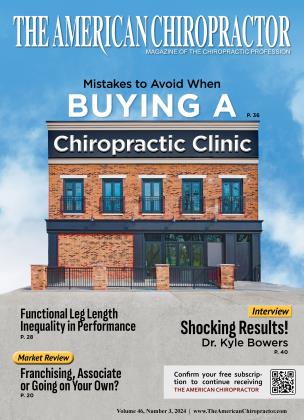Tracing the Path from Pain to Relief
by Dr. Richard E. Busch III
Background: A 70-year-old 100.4-pound female patient, let's call her Mrs. A, complained of upper back and neck pain with paresthesia, radiating into the left trapezius upper thoracic spine bilaterally into the superior aspect of the chest and upper extremities bilaterally to the elbow and into the left forearm and hand muscle weakness. The patient's quality of pain was constant ache and tingling, intermittent burning, sharp shooting severe pains with an estimated range of 5/10 to 10+/10 pain. The patient complaints were progressive and began in the cervical spine and slowly began into the bilateral trapezius upper thoracic spine in the scapular areas into the shoulders and chest, and eventually, chronic abdominal pain with bloating affected the upper bilateral quadrants of the abdomen. Other complaints involved digestive disturbances, heart palpitations, elevated heart rate, and Vertigo.
History: Mrs. A became symptomatic following a boating injury where she fell against her left shoulder and struck her head. The other symptoms included low back pain with bilateral radicular symptoms from the lumbar spine buttocks and posterior thigh and calf bilaterally. The patient was also type 2 diabetic and prescribed the medication Ozempic, which caused her to develop gastroparesis with other complicating factors, including global pain phenomena and postural orthostatic tachycardia syndrome (POTS) .
Mrs. A noticed improvement with laying supine, heat, hot water soaks, nonsteroidal anti-inflammatories, and analgesic creams like Biofreeze or Ben Gay. She experienced increased discomfort in bending, lifting, twisting, standing, walking, sitting, reading, and working with her hands, as well as elevated stress levels. A gastroenterologist and neurologist had evaluated her, but she received little treatment (gabapentin) with no actual recommendations for treatment from these professionals. She did seek treatment from a chiropractor, where she received limited treatment and no improvement. The medical model for this situation was broken; it is to either medicate or operate. If you are not a candidate for either of these, you don’t have a problem that warrants treatment. She was unable to receive any improvement from treatment prior to her presentation to this office.
Exam: Mrs. A presented with cervical, thoracic, and lumbar spine X-rays and multiple MRIs. She was evaluated with standard chiropractic, orthopedic, and neurologic testing.
Discussion: She was diagnosed with herniated and degenerative disc in the cervical spine and neuropathic changes in the upper torso and the autonomic nervous system, as well as radicular symptoms in the lower extremities; she had been seeking relief but was unable to find any. She was placed under a treatment plan that included the DRS protocolTM using spinal decompression, Low-Level Light, and Laser therapy (LLLT) on the upper extremity, as well as nutritional support, including vitamin C, magnesium, bromelain, with chiropractic manipulation. She was also evaluated with Dr. Loomis’ Enzyme protocol and started on digestive enzymes. By the third visit, she was noticing improvement in most symptoms. The supplementation was to benefit her digestion and help ease her abdominal pain. She was re-evaluated on the 10th visit and noticed remarkable improvement. Bilateral upper and lower extremity strength was normal, and all the orthopedic findings in the cervical and lumbar spines were negative, except for cervical maximum compression on the left, which still elicited pain in the left trapezius and neck. At this time, she had been experiencing mild improvement in the pain intensity, and her range of motion was improving as well, but to a small degree. On the evaluation day, we began with spinal manipulation using an instrument, which helped with the pain and the ROM, and she was then given exercise recommendations. From that point forward, her improvement accelerated, and her pain dissipated more rapidly. The patient was re-evaluated on the 28th visit with no positive orthopedic findings, mild palpatory tenderness, and full range of motion in the cervical and lumbar spines. She did still have some mid-thoracic spine tenderness and fixation and was given the instructions to continue the enzymes as well as the exercise regimen and moved to a supportive care plan. The supportive care plan consisted of the same modalities she had received; however, the frequency of treatment was moved to 3-4 weeks.
Conclusion: The only limit we have as chiropractors is what we place on ourselves. This patient had been told nothing was wrong and that the problems were in her head. She was told the medication she received that caused the gastroparesis was not part of the cause, and there was nothing that could be done with autonomic neuropathy; it was permanent. Over the last 28 years I have been in practice, we have made great strides as a profession. We are having more success treating more complicated problems while gaining better reputations and results. I have found a lot of the success we experience with the improved technology available in the conservative treatment arena and have found that by combining several of these modalities, we can increase the scope of problems we treat and continue to improve the results we see in chiropractic. Do not be afraid of technology; embrace it and learn how it works. Learn how to combine some of these treatments into new protocols and change the future of healthcare. The future is not for the settlers; It is for the innovators!
 View Full Issue
View Full Issue






